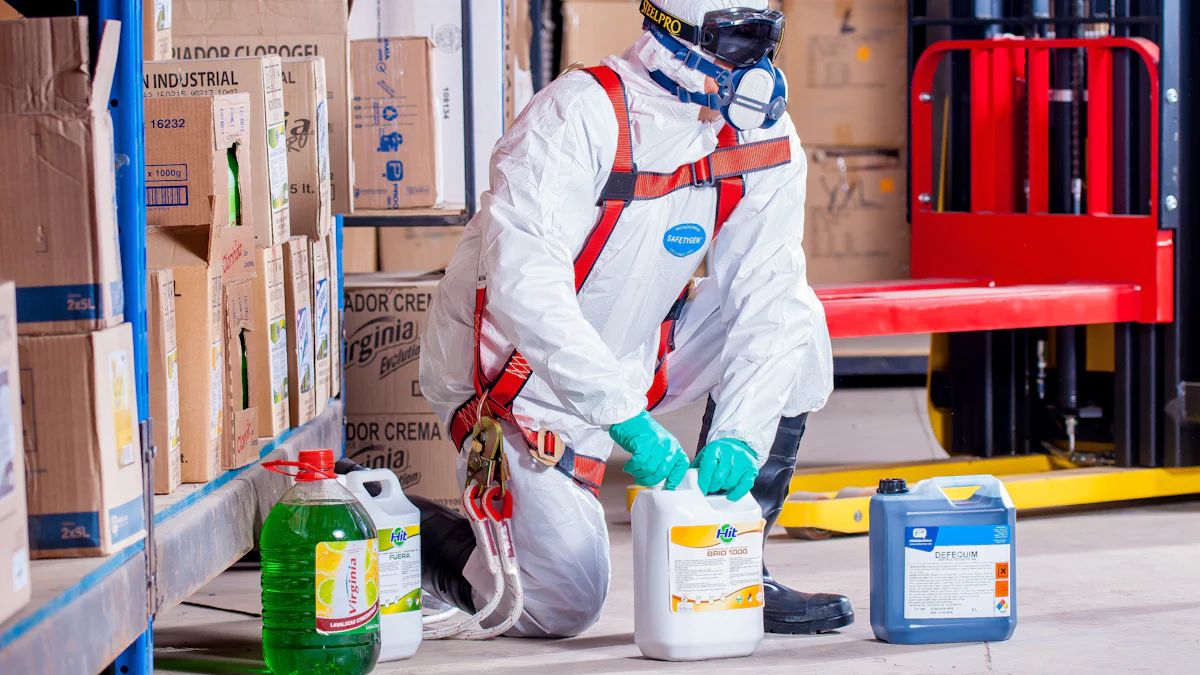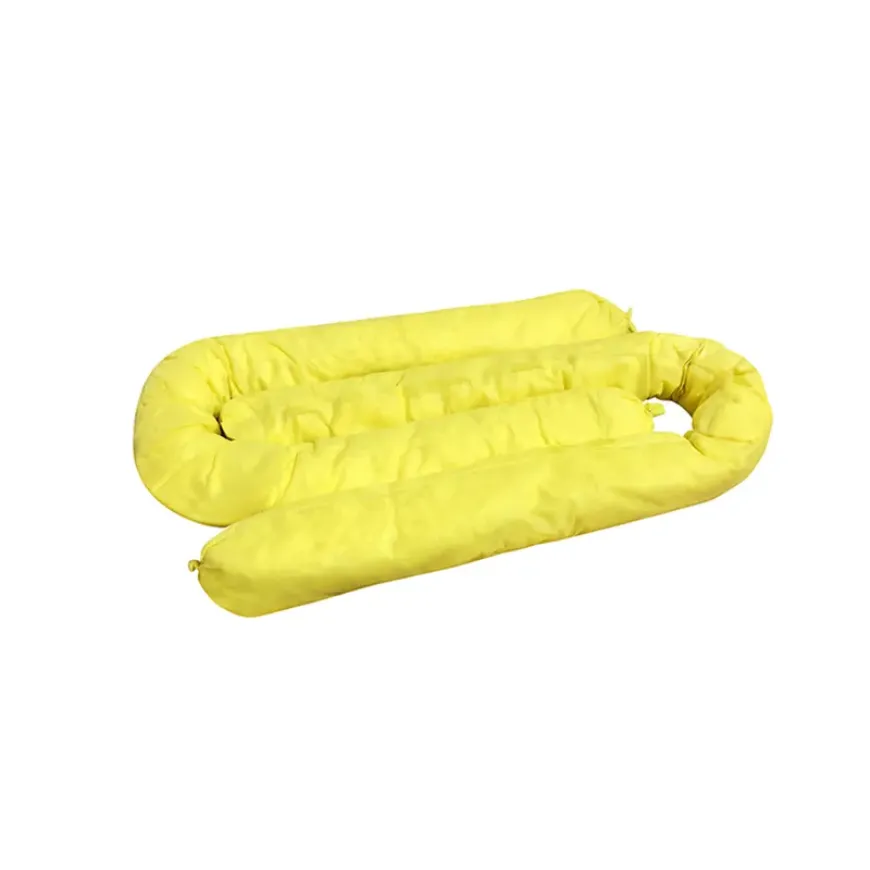
Hazardous spills can happen when you least expect them, and managing them quickly is critical. That’s where hazmat absorbent socks come in. These tools are designed to contain and absorb dangerous liquids, keeping you, your team, and the environment safe. But using them the wrong way can lead to serious risks.
Here’s a quick look at what can go wrong:
Risk Type | Description |
|---|---|
Chemical Injuries | Direct body contact with cleanup waste without PPE can lead to injuries. |
Misleading Information | Using absorbent socks incorrectly can misrepresent the severity of leaks, leading to harm. |
Improper Disposal | Incorrect storage and disposal of saturated absorbents can cause dangerous chemical reactions. |
To avoid these risks, always check the MSDS of Hazmat Absorbent Socks before use. This ensures you’re prepared to handle spills safely and effectively. By following the right steps, you can protect yourself and the environment while managing spills with confidence.
Key Takeaways
Check the type and size of the spill first. This helps you pick the right tools and stay safe.
Use UPQUARK Hazmat Absorbent Socks to clean spills well. Their bright yellow color and bendable shape make them great for stopping dangerous liquids.
Place the socks around the spill to stop spreading. Overlap the ends to seal the area and soak up the liquid.
Throw used socks in special hazardous waste bins. Follow local rules to get rid of them safely.
Wear proper safety gear (PPE) when cleaning spills. This keeps you safe from harmful chemicals.
Preparing for Effective Spill Management

Assessing the Spill
Identifying the type of spill
Before jumping into action, you need to figure out what kind of spill you’re dealing with. Is it a chemical spill, like acids or alkalis? Or maybe it’s oil or another corrosive liquid? Each type of spill comes with its own risks. For example:
Chemical spills can release toxic fumes or cause burns.
Biological spills might involve infectious materials like blood.
Radiological spills are rare but require specialized handling.
Knowing the type of spill helps you choose the right tools and safety measures.
Evaluating the size and severity of the spill
Next, take a good look at how big the spill is. Is it a small puddle or something more widespread? A minor spill might only need one or two absorbent socks, while a larger one could require multiple tools. Also, assess the severity. Is the liquid spreading quickly? Does it pose an immediate danger to people or equipment? This evaluation will guide your next steps.
Choosing the Right Hazmat Absorbent Socks
Selecting UPQUARK Hazmat Absorbent Socks for hazardous materials
When it comes to hazardous spills, UPQUARK Hazmat Absorbent Socks are a top choice. Their bright yellow color acts as a warning sign, and they’re designed to handle tough spills like acids, alkalis, and other corrosive liquids. Plus, their flexible design makes them perfect for wrapping around leaks or creating barriers.
Feature | UPQUARK Hazmat Absorbent Socks | Other Brands |
|---|---|---|
Color | Bright yellow for danger warning | Varies |
Absorption Capability | Absorbs most acids, alkalis, corrosives | Varies |
Packaging | Moisture-proof, foldable plastic | Often cardboard |
Ensuring compatibility with the spilled substance
Not all absorbent socks work for every spill. Always check if the socks are compatible with the liquid you’re dealing with. UPQUARK Hazmat Absorbent Socks are chemically inert, so they won’t react with most hazardous materials. This makes them a reliable choice for a wide range of spills.
Implementing Safety Measures
Wearing appropriate personal protective equipment (PPE)
Safety first! Before handling any spill, put on the right PPE. This might include gloves, goggles, face shields, or even a full-body suit if the spill is particularly dangerous. Respirators are also a must if there’s a risk of inhaling toxic fumes.
Establishing a safe perimeter around the spill area
Once you’re suited up, secure the area. Keep others away from the spill by setting up a clear perimeter. This prevents accidental exposure and gives you space to work safely. Communicate the hazard to everyone nearby and evacuate if necessary.
Tip: Always have a spill response plan in place. It’s better to be over-prepared than caught off guard.
Step-by-Step Application of Hazmat Absorbent Socks

Placement of Absorbent Socks
Encircling the spill to prevent further spread
Start by surrounding the spill with absorbent socks. This step is crucial to stop the liquid from spreading further. Arrange the socks in a circular or oval shape, depending on the spill’s size and location. Make sure the entire perimeter of the spill is covered. If the spill is near machinery or containers, wrap the socks around the base to catch any additional drips or condensation.
Overlapping sock ends to create an effective barrier
When placing multiple absorbent socks, overlap their ends slightly. This creates a seamless barrier that prevents gaps where the liquid could escape. Use enough socks to fully contain the spill and ensure the barrier is secure. Regularly check the placement to confirm the socks are holding the liquid effectively.
Tip: Always inspect your absorbent socks before use. Replace any that show signs of wear or damage to maintain their effectiveness.
Ensuring Maximum Contact
Pressing socks gently to ensure full contact with the liquid
Once the socks are in place, press them gently against the liquid. This helps them absorb the spill more efficiently. Avoid applying too much pressure, as this could cause the liquid to spread or splash. Let the socks do the work—they’re designed to soak up hazardous materials quickly.
Adjusting placement for optimal absorption
Keep an eye on the socks as they absorb the liquid. If you notice areas where the spill isn’t being absorbed, adjust the socks’ position. You can also add more socks to areas with higher liquid concentration. This ensures maximum absorption and prevents any leftover residue.
Managing Different Spill Scenarios
Using multiple socks for large spills or linking them together
For larger spills, you’ll need multiple absorbent socks. Link them together by overlapping their ends, just like you would for smaller spills. This creates a continuous barrier that can handle a significant amount of liquid. Pairing the socks with other tools, like absorbent pads or booms, can enhance your spill response and make cleanup more efficient.
Handling reactive chemical spills with caution
Dealing with reactive chemicals? Take extra precautions. Start by increasing ventilation in the area and, if possible, neutralize the chemical using appropriate agents. Then, use the absorbent socks to contain the spill, working from the edges inward. Always collect and dispose of the used socks in designated hazardous waste containers. Don’t forget to decontaminate the area and your equipment afterward to ensure safety.
Note: Reactive chemicals can be unpredictable. Always follow your spill management plan and wear the recommended PPE to protect yourself.
Post-Use Procedures for Hazmat Absorbent Socks
Proper Disposal of Used Socks
Placing saturated socks in designated hazardous waste containers
Once you’ve contained the spill, it’s time to dispose of the used absorbent socks properly. Place the saturated socks in chemical-proof hazardous waste containers. Avoid mixing different types of saturated absorbents in the same bag, as this could lead to dangerous chemical reactions. Always label the containers clearly to indicate the type of waste inside. This step ensures safety during transportation and disposal.
Tip: Never incinerate used absorbent socks. Burning them can release toxic gases, which could harm both you and the environment.
Following local hazardous waste disposal regulations
Disposing of hazardous waste isn’t just about safety—it’s also about compliance. Follow your local regulations to ensure proper disposal. For example:
Notify the EPA or your state agency about hazardous waste activities using Form 8700-12.
Use a manifest when transporting waste off-site.
Recycle or treat waste on-site if allowed by regulations.
By adhering to these rules, you’ll avoid fines and help protect the environment.
Decontamination and Cleanup
Cleaning the affected area after spill containment
After the spill is contained, focus on cleaning the area thoroughly. Start by collecting all used absorbent materials and placing them in designated containers. Then, use a long-handle brush to scoop up any remaining debris. Clean the surface with an environmentally friendly decontaminant to remove any residue. This step ensures effective cleanup and prevents future hazards.
Note: Wash your hands and any clothing that came into contact with the spill. This reduces the risk of exposure to harmful substances.
Safely removing and disposing of PPE
Your personal protective equipment (PPE) also needs proper handling. Remove your gloves, goggles, and other gear carefully to avoid contamination. Dispose of all contaminated PPE in hazardous waste containers. Make sure the waste is labeled and stored correctly before transporting it to an authorized facility. Following these steps keeps you safe and ensures compliance with spill response protocols.
Reminder: Always double-check local, state, and federal regulations for disposing of PPE and other hazardous materials.
By following these post-use procedures, you’ll complete your spill management process safely and efficiently. Proper disposal and decontamination not only protect you but also contribute to a cleaner, safer environment.
Using hazmat absorbent socks effectively boils down to three key steps: preparation, application, and disposal. First, always assess the spill and choose the right tools, like UPQUARK hazmat absorbent socks, to ensure safety. Their bright yellow color helps you quickly identify them during a spill response, reducing confusion and improving efficiency. Next, apply the socks correctly by encircling the spill and ensuring maximum contact for optimal absorption. Finally, dispose of used socks properly and follow local regulations to protect the environment.
By following these steps, you not only manage spills efficiently but also contribute to a safer workplace and a cleaner planet. Remember, preparation and proper spill management go hand in hand. So, stay ready, act fast, and always prioritize safety.
Tip: Using environmentally friendly tools like UPQUARK hazmat absorbent socks benefits both your team and the environment. Their durable, water-resistant packaging and flame-retardant materials make them a reliable choice for any spill response.
FAQ
What makes UPQUARK Hazmat Absorbent Socks different from other brands?
UPQUARK socks stand out with their bright yellow warning color, ultra-absorbent polypropylene fibers, and flexible design. They handle corrosive liquids like acids and alkalis while resisting wear and tear. Plus, the eco-friendly, water-resistant packaging ensures they’re ready when you need them.
Can I use UPQUARK Hazmat Absorbent Socks for all types of spills?
These socks work for most hazardous spills, including chemicals, oils, and corrosive liquids. Always check the compatibility of the socks with the spilled substance before use. Their chemically inert design ensures they won’t react with most materials.
How much liquid can one UPQUARK Hazmat Absorbent Sock absorb?
Each sock absorbs up to 3.5 liters of liquid. A single box provides a total capacity of 56 liters, making it ideal for managing both small and large spills effectively.
Are UPQUARK Hazmat Absorbent Socks reusable?
No, these socks are designed for single use. After absorbing hazardous materials, dispose of them in designated hazardous waste containers following local regulations to ensure safety and compliance.
How should I store UPQUARK Hazmat Absorbent Socks?
Store them in their original, moisture-proof packaging. The foldable plastic box with a Velcro seal keeps them dry and ready for emergencies. The optional fluorescent sticker ensures you can locate them quickly, even in low-light conditions.
See Also
Essential Tips for Users of Oil Absorbent Socks
Understanding Practical Uses of Oil Absorbent Socks

